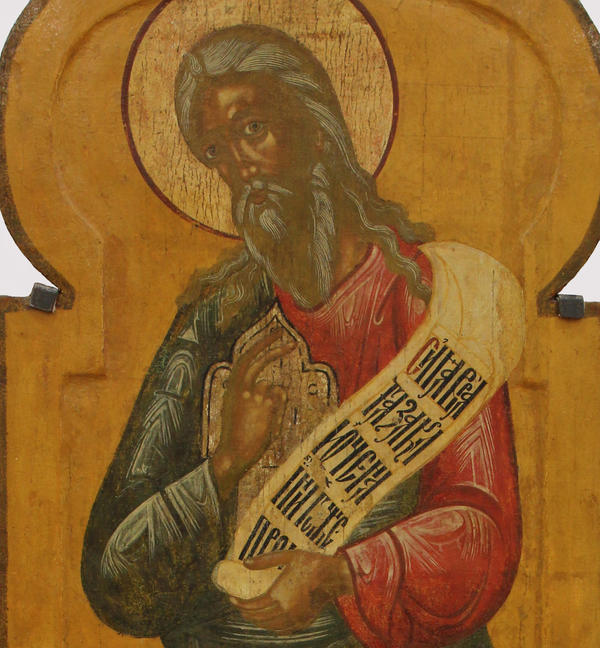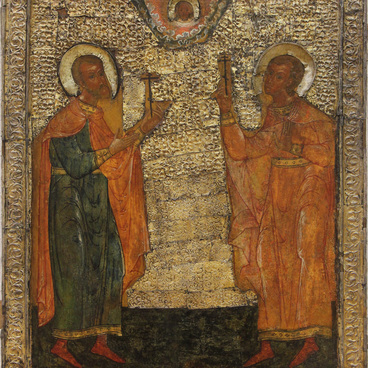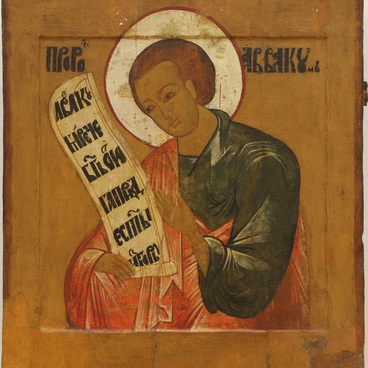Ezekiel the Prophet and the Crucifixion
Creation period
Late 17th – early 18th century
Dimensions
143,7x51,2 cm
143.7х51.2х3.5 cm
143.7х51.2х3.5 cm
Technique
Wood, tempera
Exhibition
0
Open in app#11
Unknown author
Ezekiel the Prophet and the Crucifixion
#3
#2
Ezekiel the Prophet is one of the Old Testament prophets, his life and prophecies are described in the Bible’s Book of Ezekiel. He prophesied “resurrection of the dead” and the end of the Babylonian captivity of the Jews in the 6th century BCE. Ezekiel was the first to describe the tetramorph, a mystical winged creature with the faces of the angel, ox, lion and eagle. These four creatures in the iconography became symbols associated with the four evangelists, where the angel is St. Matthew, the lion Mark, the ox Luke and the eagle John.
#4
Iconography
#5
Ezekiel’s image was placed in the iconostasis where his was the mandatory icon in the prophet’s tier. This segment of the iconostasis depicted the prophets after Moses and before Jesus Christ. Above it was a tier with the first Biblical characters: Adam, Eve and Abraham. Icons below the prophets’ tier depicted the 12 feasts and scenes from the Gospel, included were the Nativity of the Virgin Mary, Presentation in the Temple of the Virgin Mary, Nativity of Christ, Baptism of Jesus and other major events of the New Testament. In the Russian Orthodox Church, these days are called the twelve great feasts. Iconostases also had a lower tier of icons of the locally venerated saints.
#6
The icon
#12
The smaller northern churches had but just a few icons in front of the altar. Iconostases were composed of two-part icons that depicted a prophet in the upper part, and one of the twelve feasts in the lower one.
The icon from the collection of the State Museum of Fine Arts of Khanty-Mansiysk was painted between the late 17th and early 18th century in the Vologda region in the north of Russia. It shows Ezekiel the Prophet above and the Crucifixion below.
#8
The Crucifixion used a simplified iconographic version, as in the more complete version there are two more crosses on either side of Jesus. Two convicted thieves crucified alongside the Saviour are referred to in the biblical texts as the Good (or Wise) Thief and the Bad (impenitent) Thief.
#9
Technique
#10
The Vologda artisans used a wood panel with a figured, keel-shaped top. The wood was covered with a linen cloth and several coats of chalk. The icon was painted with tempera, made from powdered pigments and raw egg yolk. The frame was painted with ochre, based on rust and clay, which, to get a lighter tone in the lower icon, had some white paint added to it.
#13
State Museum of Fine Arts of Khanty-Mansiysk
read morehide
00:00
00:00
1x
Ezekiel the Prophet and the Crucifixion
Creation period
Late 17th – early 18th century
Dimensions
143,7x51,2 cm
143.7х51.2х3.5 cm
143.7х51.2х3.5 cm
Technique
Wood, tempera
Exhibition
0
Open in app
Share


